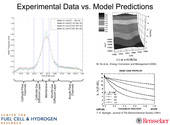Highlight
Break Through on Water Measurement in Fuel Cell
Achievement/Results
Graduate student Daryl Ludlow and Professor Michael Jensen at Rensselaer Polytechnic Institute have obtained the first experimental data of water content in the membrane of an operating low- temperature proton exchange membrane (PEM) fuel cell. These data indicate that previous detailed numerical models fail completely to capture the governing mechanisms involved with membrane hydration in PEM fuel cells.
This NSF-supported research (through the Integrative Graduate Education and Research Traineeship – IGERT – program) will lead to improved understanding of these fuel cell processes and should contribute to more efficient and durable designs. Fuel cell technology has the potential to change the way we convert energy to a more efficient and environmentally friendly one. The impact of fuel cells extends further than just energy conversion, with the potential to transform the entire energy industry. Unfortunately, fuel cells have many barriers to overcome before they gain widespread acceptance.
PEM fuel cells are one of the two fuel cell types that have attracted most research and commercial interest. However, the performance of PEM fuel cells depends on the hydration of the membrane. Increasingly complex numerical models attempt to accurately capture governing mechanisms within fuel cells – and might actually do so – but experimental data to verify those details were not available until now. As shown on the attached figure, previous predictions (two right hand side figures) of water concentration in the membrane decreased monotonically from the cathode to anode side of the fuel cell. However, using the Neutron Imaging Facility at the National Institute of Standards and Technology, the water distribution in the membrane and gas diffusion layers was measured (figure on left hand side). This unexpected and complex distribution with a peak in the center of the membrane suggests that the structure of the membrane is affected by skin effects at the interface. Research is continuing to explain these results.
Address Goals
This result provides essential insight and knowledge into the processes governing the performance of a low-temperature proton exchange membrance fuel cell. This insight should allow designers of fuel cells to develop better approaches to accommodate the unusual behavior we observed and to use this knowledge to improve the performance of the fuel cell.






